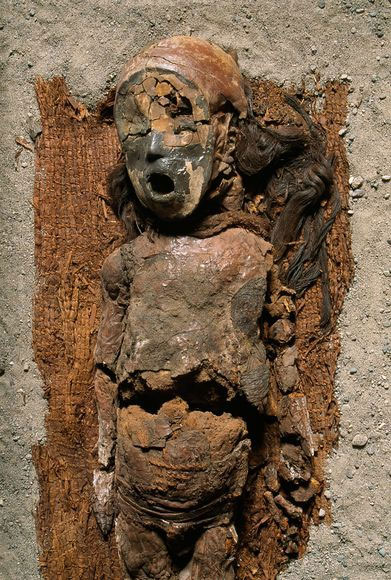Indians have embalmed the body 5,000 years ago
The South American Indians of the Chichorro culture living in the desert Atakama has mastered the technique of turning the dead into a mummy thanks to climate change from 5 to 7 thousand years ago. That is the conclusion of archaeologists in a work published in the Proceedings of the National Academy of Sciences.
>>>Mysterious mummies of the desert of Chile
Chichorro culture appeared about 10 thousand years ago in the territory of Peru and Chile today. Indians live in small villages, eat catches from the sea and live very simply. Chichorro is one of the first tribes of South American Indians to master the technique of embalming.
Their mummification technique is not very complicated, only a few stages. First of all, people pecked away the deceased person's abdomen to remove organs, brain, skin and then apply with clay and paste it on the skin patches that had been removed. It is unclear here that they only mummified for their purpose because their custom does not conduct burial rituals and there is no conception of life after death.

The group of archaeologists led by Pablo Marquet of Santiago Catholic University in Santiago monitored climate change in the desert, after studying glacial sediments in Bolivia. If you know the history of the glacier lake, you can understand the appearance of the ancient Atacama.
According to Pablo Marquet and his colleagues, the Sakhama glacial lake conceals within it the traces of two periods of relatively mild and favorable climate throughout the Atacama region. The first phase begins before the emergence of humans in the New World about 14,000 years ago and lasts about 3 millennia. The later period started 7 thousand years ago and was shorter, only for 2000 years.
Scientists compare climatic documents with archaeological documents, the number and scale of villages in Chinchorro at different times and then use those facts to model population fluctuations. the number of Indians.
The results allow them to conclude: the population of the Atacama desert thrives in the second phase, when the climate becomes pleasant and then suddenly drops to about 4.9 thousand years ago. The 'population explosion' involves two factors: abundant water and food. As a result, Chinchorro moved to a settled lifestyle and began to culturally evolve.
One of the products of this evolution is the art of embalming. Researchers believe that the Atacama desert itself suggests to the Indians this culture. The bodies of the animals that live in the desert due to the very dry climate and intense sunshine are almost undamaged. The embalming technique is also based on the dryness of the air and solar heat.
However, why did they conduct the burial of the dead in such a complicated way? Marquet and his colleagues believe that the embalming technique appeared because in the life of a Chinchirro Aboriginal people there were too many deaths. On average, each person in a tribe of several hundred people participated in the funeral of a few dozen people.
- The Khmer monks revealed the secret of embalming the body
- How does the Egyptian manipulate the mummy coffin?
- Amazing scientific knowledge of ancient Indians
- The secret to mummification is unique in the Philippines
- Native Americans are of Siberian origin
- Think ahead of the time of the Indian gender and sexual orientation
- Buried monkey people died 153 years
- Shivered with the corpses kept in the house without being buried
- India grows 50 million trees in just one day
- The mystery of the corpse after 23 years remains intact
- Mixtecs used cremation longer than we thought
- The oldest remains reveal the Native American origin in the Americas
 Discovered an ancient centipede fossil 99 million years old
Discovered an ancient centipede fossil 99 million years old Discovered bat-like dinosaurs in China
Discovered bat-like dinosaurs in China Discovered a 200-year-old bronze cannon of the coast
Discovered a 200-year-old bronze cannon of the coast Discover 305 million-year-old spider fossils
Discover 305 million-year-old spider fossils